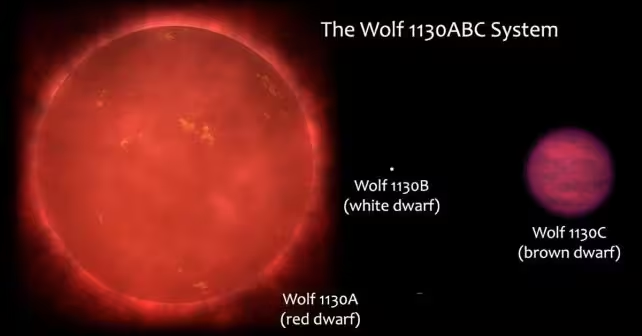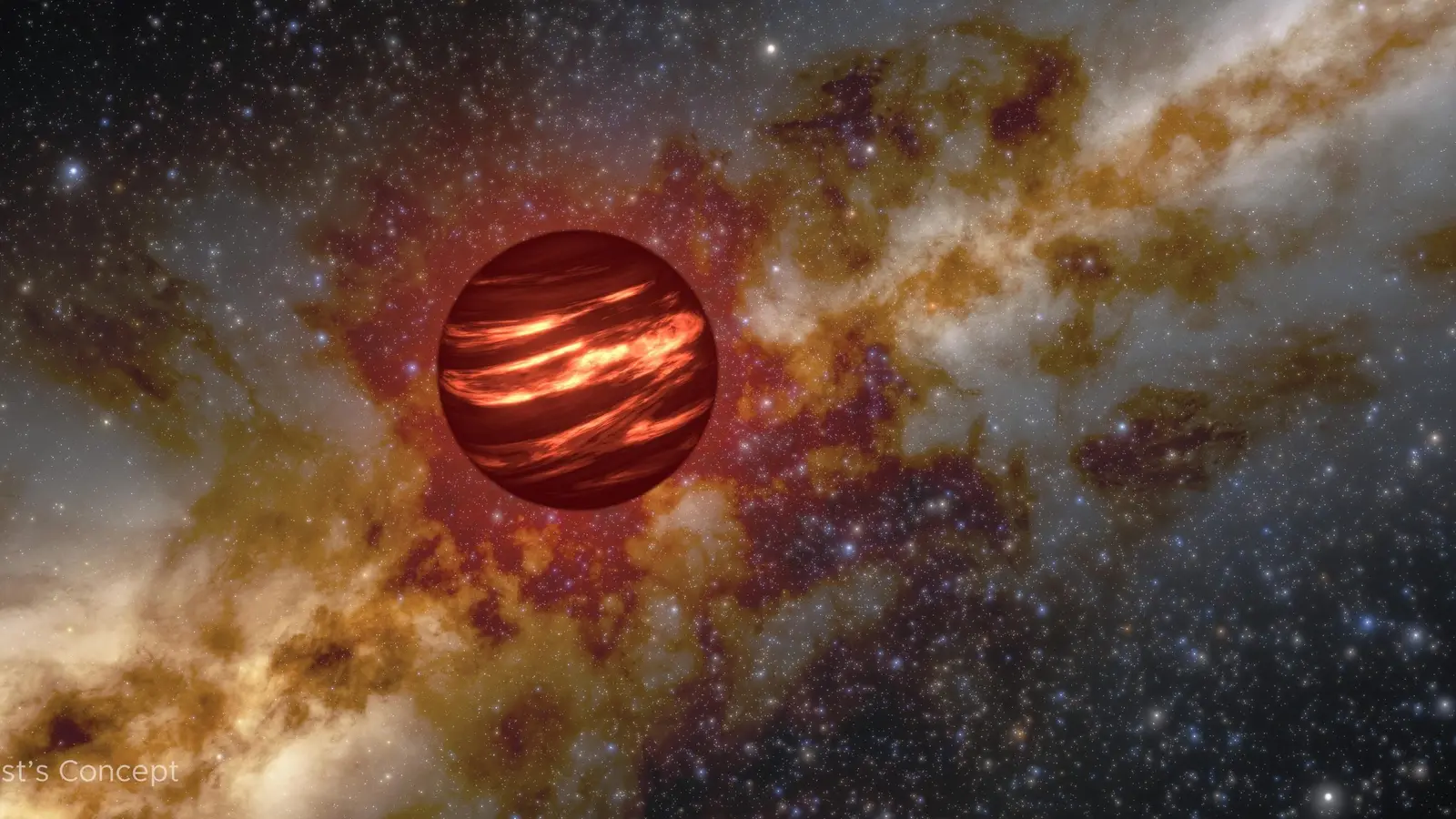6 Minutes
Discovery at a glance
An international team led by astrophysicist Adam Burgasser (University of California, San Diego) has reported a clear detection of phosphine (PH3) in the atmosphere of the brown dwarf Wolf 1130C, located about 54 light-years from Earth. The brown dwarf—an ancient object estimated to be more than 10 billion years old—shows a phosphine abundance on the order of 100 parts per billion. This is the first robust detection of PH3 in a brown dwarf at the abundance predicted by prevailing atmospheric chemistry models.
Why this detection matters for phosphorus chemistry and astrobiology
Phosphine has attracted widespread attention as a potential biosignature because, on Earth, it is primarily produced by anaerobic microbes. Its 2020 announcement in Venus’ atmosphere intensified debate about non-biological formation routes for PH3 and how to interpret such detections. Outside the Solar System, phosphine is known in Jupiter and Saturn; there it forms deep in hot, high-pressure regions and is transported upward by convection.
Finding PH3 in Wolf 1130C at abundances similar to those in Jupiter and Saturn confirms that, under some conditions, phosphorus chemistry behaves as models predict. However, the broader pattern is puzzling: multiple searches of other brown dwarfs and giant exoplanets using ground-based telescopes and the James Webb Space Telescope (JWST) have failed to find PH3 at the expected levels. That inconsistency suggests missing pieces in our understanding of how phosphorus-bearing molecules form and persist in hydrogen-rich, low-temperature atmospheres.
Because phosphine can arise from both biological and abiotic processes, this new detection reinforces caution in treating PH3 as a definitive sign of life on other worlds. The Wolf 1130C result shows that phosphine’s presence—or absence—depends on atmospheric context and elemental composition, meaning that PH3 is not a straightforward biosignature without careful environmental constraints.
Observations and methodology
The research team used JWST to acquire infrared spectra of Wolf 1130C, searching for the characteristic absorption bands of PH3. Infrared spectroscopy reveals molecular ‘‘fingerprints’’ as molecules absorb specific wavelengths of light. In this case, the PH3 signature appeared prominently in the spectral data; Burgasser described the feature as surprisingly obvious even in the lowest-resolution measurements. The inferred abundance—about 100 parts per billion—matches values produced by standard disequilibrium chemistry models developed from studies of Jupiter and Saturn.
This detection relied on precise calibration and modeling of the brown dwarf’s thermal structure and chemistry. The agreement between observation and model for Wolf 1130C stands in contrast to many other objects of similar type where PH3 is conspicuously absent or present only as faint traces.
Context: brown dwarfs as atmospheric laboratories
Brown dwarfs occupy the mass range between the most massive planets and the smallest hydrogen-fusing stars. They lack sustained nuclear fusion and cool over time, making them valuable comparative laboratories for exoplanetary and stellar atmospheric physics. Their hydrogen-dominated atmospheres and varied temperatures allow researchers to test models of disequilibrium chemistry—processes such as vertical mixing and photochemistry that drive molecules away from their thermochemical equilibrium abundances.
The established models predict that phosphorus should primarily exist as phosphine in low-temperature, hydrogen-rich atmospheres. Those models have worked well for molecules such as ammonia (NH3), methane (CH4), and carbon monoxide (CO) in many objects. The mismatch for phosphorus—agreement for Jupiter, Saturn, and now Wolf 1130C but disagreement for other brown dwarfs and exoplanets—indicates a gap in either input assumptions (elemental abundances, vertical mixing rates, temperature–pressure profiles) or missing chemical pathways.

A diagram of the sizes of the objects in the Wolf 1130 triple-star system. (Adam Burgasser)
Clues from Wolf 1130C’s environment
Wolf 1130C is part of a triple system that includes a massive white dwarf. Burgasser and colleagues suggest two factors that may explain the brown dwarf’s unusual match to models. First, Wolf 1130C appears to have a lower abundance of elements heavier than hydrogen and helium (what astronomers call low metallicity). Changes in elemental ratios can alter chemical reaction networks and shift which phosphorus-bearing species dominate. Second, the presence of a nearby white dwarf might have influenced the local enrichment of certain elements, including phosphorus, during the system’s history—potentially increasing the phosphorus available for PH3 production in the brown dwarf’s atmosphere.
Both hypotheses are testable: future spectral observations can refine elemental abundance estimates, while more sophisticated atmospheric models can explore how metallicity and external enrichment modify phosphorus chemistry.
Implications and next steps
The immediate implication for exoplanet science and astrobiology is caution. PH3 cannot be treated as a standalone biosignature without detailed context about the host atmosphere’s composition, temperature structure, and external influences. The Wolf 1130C detection motivates several follow-up lines of work:
- Expand spectral surveys of brown dwarfs and gas-giant exoplanets across a range of metallicities and ages to map when PH3 appears.
- Refine photochemical and kinetic models for phosphorus chemistry, including alternative formation and destruction pathways under varied pressures, temperatures, and elemental ratios.
- Model the influence of binary or multiple-star environments on elemental enrichment of companion substellar objects.
These efforts will help determine whether Wolf 1130C is an outlier or if our sampling of substellar atmospheres has so far missed environmental conditions that permit PH3 formation.
Expert Insight
"Wolf 1130C gives us a crucial datapoint that both validates and complicates our models," says Dr. Leila Moreno, an atmospheric chemist at the Space Science Institute. "It confirms that phosphine can reach detectable abundances in low-temperature, hydrogen-rich atmospheres, but it also shows that we must account for metallicity, system history, and transport processes before we interpret PH3 as a biosignature. Future JWST and ground-based observations that target brown dwarfs with different metallicities will be key to untangling this puzzle."
Conclusion
The detection of phosphine in Wolf 1130C advances our understanding of phosphorus chemistry in substellar atmospheres while highlighting critical uncertainties. It underscores the need for comprehensive atmospheric characterization before assigning biological significance to particular molecules. Resolving why Wolf 1130C aligns with model predictions while many comparable objects do not will improve atmospheric models, guide future JWST and ground-based observing strategies, and refine how the scientific community uses molecules such as PH3 in the search for life beyond Earth.
Source: sciencealert


Leave a Comment